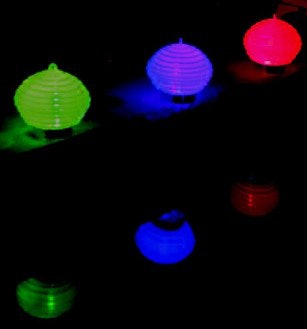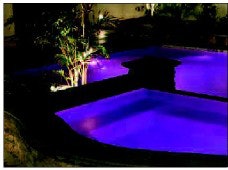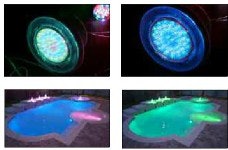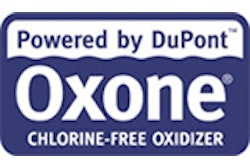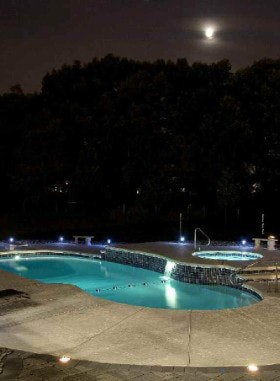
Swimming pool lighting can be as simple as a single white bulb in the deep-end wall, or a Vegas-style multicolor show choreographed to light up grottos, spas, fountains, trees, patio areas and more in sweeping swaths of changing colors.
Something in between those extremes describes the lighting in and around most backyard pools today. And the effects may be rendered with incandescent bulbs, quartzhalogen lights, fiber-optic systems, and/or the latest technology to grab the industry's fancy: light-emitting diode, or LED. (See "Finding Your Niche," page 102.)
As new lighting products continue to be developed, one indisputable trend emerges: color-changeable underwater lighting is no longer a fancy add-on for only a few select pools. Today, more than half of all new pools have colored underwater lighting, says Paul Canavan, lighting product manager at Hayward Pool Products.
"Prior to 2000, fewer than 15 percent of new pools were built with color-changing lights," notes Kevin Potucek, Hayward's vice president of marketing, adding that only fiber-optic perimeter lighting systems were widely available at that time.
In 2000, SAm (Spectrum Amerlite) and SAL (Spectrum AquaLight), now available from Pentair Water Pool and Spa, hit the scene. These halogen lights were the first to offer underwater color-changing pool lights, and the concept has taken off. They use a rotating color wheel to offer combinations of seven different colors, explains David MacCallum, Pentair's lights and automation product manager.
LED: A Shining Star
While quartz-halogen color-changing systems like SAm lights are still dominant, the industry is abuzz about LEDs. In the past few years, several pool industry manufacturers have introduced LED systems with color-changing capabilities that rival and in some ways improve upon what lights like SAm can do. LEDs have some compelling selling points: they last tens of thousands of hours, do not generBRIG H T IDEAS An illuminating look at today's pool lighting technologies ate heat, and can produce fasterchanging light shows than other forms of colored lighting.
Another advantage of LEDs, according to Richard Heiner, director of marketing for Super Vision International, is that for the same cost as one old-fashioned headlight-style lamp in the deep end, you can put three LEDs in a larger pool. Plus, he notes, the technology is well suited for lighting uniquely shaped pools with compound curves.
LEDs also can yield as great as 90 percent savings in energy costs compared with halogen and incandescent products, says CJ Haney, sales and marketing manager at O'Ryan Industries, which began offering a colorchanging LED spa light in 1998.
Perhaps the biggest difference with LED is that all of your energy is going to generating the color, explains Canavan. "LED doesn't start with white and subtract, like the color-wheel system does. LED produces a color, so it's richer. You get higher color saturation than with subtractive color technologies."
Because of these and other advantages, it won't be long before LED is the industry mainstay, say most experts.
"We're at the infancy level of where LED technology is going," Canavan continues, comparing LEDs to the growth trend of some consumer electronics. "Four years ago, plasma TVs cost $10,000. Already they cost 70 percent less and are getting better all the time. That's where LEDs are. The brightness is going up, and the cost is coming down."
The availability of new, exciting lighting products is not the only factor in the growth of colored lighting. Consumer demand is also in play.
"Homeowners have gotten more sophisticated about their backyards, and one of the things they're expressing more interest in is lighting," says Brian Cullingworth, a high-end builder in Temecula, Calif.
And it's not just pool and landscape lighting, but also accent lighting. "We're definitely seeing more interest in all kinds of backyard lighting," says Mitch Smith, national sales manager for GAME, which has recently introduced several accent-lighting products, including one that floats in a pool and makes disco-like effects dance on the walls and floor.
Such products bring colorful lighting to customers with lower budgets. Meanwhile, permanently installed colored lighting is the kind of upgrade that customers with bigger budgets tend to request and appreciate.
"The Internet has helped," notes Cullingworth. "People go online and see magnificent pools, which they then want to replicate."
Still, many builders continue to offer white quartz-halogen lights as their basic lighting package, with color options as an upgrade.
"If a client is on a budget, they get two quartz-halogen lights," says Ron Gibbons, owner of Gibbons Pools, Islandia, N.Y. Then again, Gibbons notes, in a traditional, Roman-end pool, which he's building a lot of lately, a pair of halogen lamps does the job.
Many respected builders caution against overdoing lighting. In fact, a very bright pool with relatively dark surroundings can be a safety hazard. "Pool lights are sometimes so bright, that without good landscape lights, people outside the pool can't see where they're walking," says Gibbons. For that reason, Gibbons often selects incandescent lights because they can be dimmed. "We like to make it look like the pool is just barely glowing," he says, adding that Jandy's AquaLink controls make this effect easy to accomplish.
Light Shows
Gibbons has also been known to put more than 2,000 fiber-optic spots in a pool floor and call the effect "starry night." The first time he did it, he used pencil-sized stainless-steel light niches with tiny lenses on each one. Three years later, his supplier had developed an acrylic niche, which simplified the job.
Builders have also used fiber-optic technology to create starry night effects in grotto roofs. "That's an incredible environment," says Cullingworth, adding that when customers want thousands of tiny color-changing lights in a cave, one-third of the pool's cost can be in lighting.
Whether the pool is lit with one lamp, thousands, or some number in between, one important aspect of lighting design is to avoid shadows. Therefore, the farther the pool shape is from a basic rectangle, the more thought needs to go into lighting. "Lagoons and geometric shapes need more lights because light doesn't bend around corners," Gibbons explains.
Barry Greenwald, president of Fiberstars' pool and spa division, notes that fiber systems work well for tricky shapes because the cost to add a few small lights, say in steps, benches or alcoves, is relatively insignificant once the project has a light source.
The pool's surface also plays a role. For example, a multicolored surface, like a quartz aggregate or vinyl-liner pattern, can create interesting lighting effects, as the light bounces differently off the different parts of the pattern. But multiple lights will probably be required.
"Colored lighting isn't as bright as white," Potucek explains. So pools with colored lighting that also have dark, textured surfaces will typically require more than one light.
White incandescent or halogen lights can also be used to supplement colored lighting to add brightness.
Jeff Smart, owner of Holiday Pools in Fresno, Calif., routinely uses white lights in tanning shelves in concert with colored light in the main body of the pool. The color blends, so the whole body of water takes on the color, he says.
The lights he's using in the tanning shelves are modified Fiberstars dual bubbler fixtures (which combine fiber and LED technologies to produce illuminated fountains). Meanwhile, the colored light(s) in the main pool may be quartz-halogen or LED.
Combining different lighting technologies can produce some wonderful effects. For example, it's possible to synchronize SAm's slow, seductive light shows with changing fiber-optic colors, says MacCallum.
"The rate at which we're all introducing new lighting products, as well as the controls to automate backyard light shows, makes this a very exciting time," MacCallum concludes.
Finding Your Niche
Not sure when to use what kind of light? Consult this quick guide.
FIBER OPTICS
Unlike quartz-halogen or incandescent lights, fiber-optic lighting fixtures can be located in hard-to-wire places, as well as in shallow water or no water, because light travels from a source through plastic fibers. The electricity and heat stay at the source. Also, once the investment is made in the light source, it is relatively inexpensive to add multiple fixtures. Each fixture is a spot at the end of almost any number of fibers. Thousands of single strands may become a starry sky motif, or 75 strands can form a more standard-looking pool light. Light may also glow through the sides of a single fiber installed in a track around the perimeter of a pool or spa. A color wheel at the source can be set on one color, or put in motion to generate many colors in sequence. Fiberoptic underwater, perimeter and landscape lighting can be color-coordinated. Fiber optics are well suited for installation in sheeting waterfalls, water arcs, and other applications where the water itself takes on the glow.
BEST FOR multiple points of illumination, accents, waterfalls, perimeter lighting, adding color.
FOUNTAIN LIGHTING
Fixtures that shine on fountains are most akin to landscape lights. In addition, several suppliers now offer fountain fixtures that set the water itself aglow from within the fountain. These can be fiber optic, LED or quartzhalogen.
BEST FOR illuminating moving water.
HALOGEN – SEE QUARTZ-HALOGEN INCANDESCENT
While the term "incandescent" is usually used to describe traditional 12-volt lights, it technically is any lamp with a filament, including halogens. The only way to add color to an incandescent lamp is with a filter over the light source. Code requires installation at least 18 inches below the water surface.
BEST FOR basic installations, where only one light is required and/or the lighting budget is relatively low.
LANDSCAPE LIGHTING
Landscape fixtures can be fiber optic, LED, halogen or incandescent. A wide variety exists. Some are more compatible with pool lighting and control systems than others. Check with your controls supplier if you want to synchronize landscape and pool lights.
BEST FOR pathways and patios, uplighting trees and plantings, fountains.
LED
Short for light-emitting diodes, LEDs are programmable devices that convert electronic energy directly into light. LEDs produce "cold" light, which is very efficient and therefore less expensive per lumen (a measure of brightness) than incandescent or halogen products. LEDs also offer a broader, brighter and richer color pallet because they use the additive propert y of light (as opposed to filtering out, or subtracting, color from white). Color mixing is achieved by varying the voltages to each of the RGB (red, green, blue) color arrays. The controller for this color mixing may be either an external unit or it may be part of the lighting unit itself. LED fixtures can be as small as a pencil tip (one diode), so they can be installed in tight spaces. An LED with about 200 diodes would be as bright as a typical quartz-halogen pool light; an LED with 72 diodes would be comparable to a standard (incandescent) pool light. Many LED pool lights can be retrofited. Also, LEDs may soon replace fiber as the technology of choice for adding light to water features, particularly if a job has only a few lit water features. (For multiple features, fiber may be more cost-effective.) LED also allows for fast, exciting color-change patterns.
BEST FOR a wide variety of applications, including jobs requiring only a few lights.
PERIMETER LIGHTING
Purely decorative in nature, perimeter lighting is accomplished with fiber optics. It enhances aesthetics but does not provide a level of illumination that makes night swimming safe.
BEST FOR adding a vibrant, colorful glow to a body of water.
QUARTZ-HALOGEN
A lamp with a tungsten filament, halogen gas and quartz glass that is typically brighter than "s tandard" incandescent products. Although all quartz-halogen lights are not colored, this is the technology inside colorchanging SAm and SAL lights. Code requires installation at least 18 inches below the water surface because that much water is needed to cool the bulb.
BEST FOR relaxing underwater color-changing effects.
Sources: Paul Canavan, Hayward Pool Products; Barry Greenwald, Fiberstars; CJ Haney, O'Ryan Industries; Richard Heiner, Super Vision International; Paul L'Heureux, Crystal Fountains; and David MacCallum, Pentair Water Pool and Spa.
